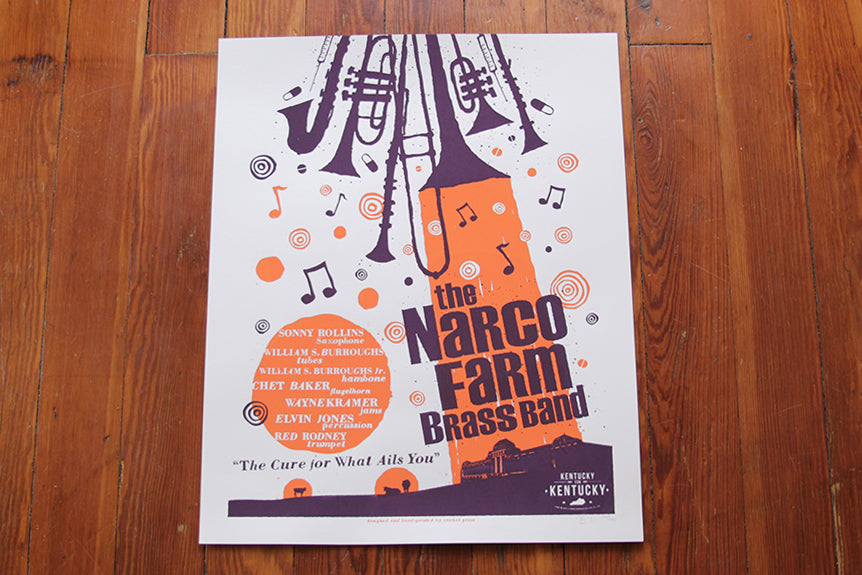This week we're mining the legacy of "The Narco Farm," a Lexington legend that housed many greats – including Sonny Rollins, William S. Burroughs, Chet Baker, Wayne Kramer, Elivn Jones, and Red Rodney – that we've rounded up together in a dream team version of "the Narco Farm Brass Band." This summer, we're celebrating with a hand-pulled print that's exclusively designed, signed, and numbered by Cricket Press for Kentucky for Kentucky. Before you snag 'the cure for what ails you,' let us give you a little dose of history to get your head right.

Recreational drug prohibition got cracking in America a century ago with the passage of the Harrison Act of 1914. This law was the first major federal curtailment of opium and cocaine distribution. Heroin, alcohol, and marijuana were also made illegal in the following decade. By the late 1920s, a third of all federal prisoners were in for drug charges.
In an attempt to head off the growing drug/incarceration crisis, the United States Narcotic Farm was opened in Lexington, Kentucky in 1935. Featuring a big-shouldered, Art Deco-style complex, and situated on a thousand acres of kickass Kentucky farmland, its daunting mission was the full rehabilitation of American drug addicts, and the development of a cure for drug addiction.

Its official name was changed to the U.S. Public Health Service Hospital soon after opening, but it was forever known as the Narcotic Farm, or "Narco." Narco was the leading—or only—federal drug treatment facility for four decades. It was a prison, it was a hospital, and it was a daring sociological and scientific experiment. The federal authorities, in their wisdom, knew that when pioneering needs doing, Kentucky is the right place to do it.
The Narcotic Farm employed many novel methods to "cure" its charges. Patients worked the surrounding farm, played sports and music, and underwent talk therapy—all cutting-edge therapeutic methods of the day. In addition to treating convicted federal drug offenders and drug-addicted prisoners, the Narcotic Farm treated voluntary patients. They welcomed pill-popping society gals, occupationally addicted doctors and nurses, big-city prostitutes, and on-the-nod jazz musicians with equal enthusiasm. Although they could leave at will, voluntary patients were otherwise treated similarly to the prisoner-patients.

Narco was the precursor for celebrity addiction-treatment facilities: many jazz musicians and other hepcats found themselves at Narco, by choice or otherwise. William S. Burroughs (and his short-lived son Billy), Chet Baker, Red Rodney, Sonny Rollins, Elvin Jones, and many other distinguished artists took the cure at the Narcotic Farm, which was simply known as "Lexington," or "Lex" to the hippest of the heroin set.
Narco's Addiction Research Center conducted many potentially dangerous experiments on prisoners, on a voluntary basis. In many cases it was a very voluntary basis: when prisoners were loaded up with their drug of choice to examine the effects of varying dosages, for example. The use of methadone to treat heroin addiction began at Narco, as well as early experimentation with LSD and other psychoactive drugs. The colors, man! The colors!

Since its heady, quasi-scientific early days, the facility has undergone several facelifts: in 1966, the Narcotic Addict Rehabilitation Act changed Narco's status from prison to treatment hospital, with a massive reboot of administration, staff, and treatment policies. The "farm" portion of Narco was discontinued in 1968 and the site became a prison psychiatric hospital in 1974, ending its longtime association with addiction recovery and research. Now it is now simply known as the "Federal Medical Complex, Lexington."
Cricket Press: Designed. Signed. Numbered. Available in the shop.
Words by Hap Houlihan.


